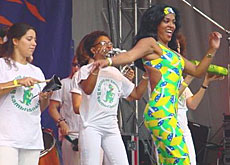
Samba beats to a Swiss rhythm

In Switzerland, carnival is practically synonymous with Guggenmusig - rowdy, costumed street bands formed specifically for the uproarious annual festivities.
Amid all this homegrown carnival mania, a Brazilian cousin, an authentic samba school, has managed to put down roots in Switzerland and even thrive.
Marked by huge parades and celebrations, carnival, or Fasnacht, started earlier this month in the Catholic cantons, officially ending on Ash Wednesday. At that point the Protestants picked up where the Catholics left off.
Founded by immigrants, the Sambrasiléia is much more than a meeting point for Brazilians pining for old country-style samba.
Its 35 members also include a fair number of Swiss, attracted in equal measure to the music and to the legendary Brazilian warmth.
But authenticity has its limits, especially when confronted with stringent Swiss anti-noise regulations. To comply with Switzerland’s different approach to loudness, the school instructs in a heavily insulated set of rooms in the basement of a building in Basel.
The noise inside the school is another story. Many of the students practise with ear protection, instrument noise sometimes reaching an ear-splitting 130 decibels.
Special soundproofing on the drums is also used, to protect the less robust Swiss eardrums.
Brazilian at heart
Karen Volota, a 40-year-old Swiss student at the Sambrasiléia, lived in Rio de Janeiro for three years. “
When I moved back to Switzerland, I wanted to keep in contact with Brazilian culture,” she said.
While in Brazil, Volota had the chance to perform with the Mangeira, the most tradition-rich samba school of Rio’s Carnival, as well as with the Mocidade Independente de Padre Miguel, considered the best formation at the Brazilian carnival.
“I love Switzerland and have lots of friend here,” said Volota. “But the human warmth of the Brazilians is lacking. The Latins are simply more open than the Europeans.”
Rhythm-challenged Europeans
Getting accustomed to samba rhythms is no easy thing. Instead of distributing sheet music, Sambrasiléia’s musical director, Adilson de Almeida, hews to practising rhythm directly.
“Initially we do the course straight through, so that the participants take in the samba rhythms,” he explained. “What comes quite naturally to a Brazilian might for others be difficult. “
Even though the non-Brazilians might not exactly have rhythm in their blood, they have other qualities that help turn a mere group into samba practitioners, according to de Almeida.
“They’re disciplined, they’re interested, and they have the patience needed to learn,” he said. “Without a lot of work and persistence you cannot achieve real goals in music, including playing percussion instruments.”
Atmosphere is key
The school places a premium on its easygoing and relaxed atmosphere. For the president of Sambrasiléia, Paul Vidal, it is important that the school climate does not become tense, especially when students make mistakes.
“We laugh about it, correct if necessary, and simply play on,” Vidal explained. “People want to have fun, but they also know they are learning samba with an eye toward performing.”
The school has played in numerous Swiss cities as well as in neighbouring Germany and France, always maintaining a festive mood.
But musical director de Almeida has begun demanding a little more from his students these past two years.
“Now I’m trying to correct their posture while carrying instruments and other details, with the intention of always becoming a little better.”
Practising at home
Rolf Kron agrees with the goal of improving. Participating in a parade with the Salgueiro from Rio was an unforgettable experience for the 53-year-old Swiss samba lover.
He never misses a lesson, but admits that learning to play the drums has not been particularly easy. “The problem is I love dancing. But when I dance I forget to play,” he explained.
Nothing if not persistent, Kron also practises at home. “I wrap my drum in a towel to muffle the noise before I practise the rhythms,” he said, “in order not to disturb the neighbours.”
The Basel-based Sambrasiléia samba school was founded by a group of Brazilians in 2002.
The 35-member group, which includes several Swiss, is made up of percussion players, singers and dancers.
Sambrasiléia meet for practice in a soundproofed basement room to avoid complaints from neighbours.
This year’s carnival season began in Lucerne and other Catholic regions on February 3.
Festivities in the Protestant regions, including Basel, started on February 14.
The capital, Bern, celebrated its carnival between February 10 and 13.
(Adapted from German by Kathleen Peters)

In compliance with the JTI standards
More: SWI swissinfo.ch certified by the Journalism Trust Initiative






























You can find an overview of ongoing debates with our journalists here . Please join us!
If you want to start a conversation about a topic raised in this article or want to report factual errors, email us at english@swissinfo.ch.